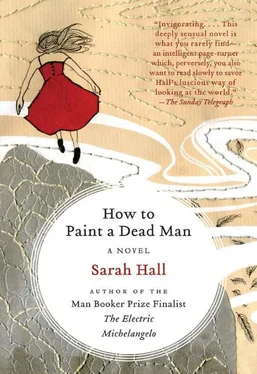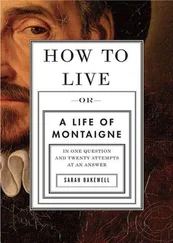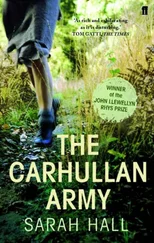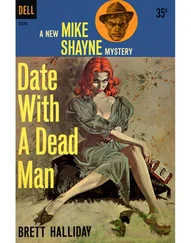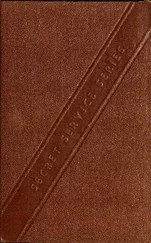Sarah Hall - How to Paint a Dead Man
Здесь есть возможность читать онлайн «Sarah Hall - How to Paint a Dead Man» весь текст электронной книги совершенно бесплатно (целиком полную версию без сокращений). В некоторых случаях можно слушать аудио, скачать через торрент в формате fb2 и присутствует краткое содержание. Год выпуска: 2009, Издательство: Harper Perennial, Жанр: Современная проза, на английском языке. Описание произведения, (предисловие) а так же отзывы посетителей доступны на портале библиотеки ЛибКат.
- Название:How to Paint a Dead Man
- Автор:
- Издательство:Harper Perennial
- Жанр:
- Год:2009
- ISBN:нет данных
- Рейтинг книги:4 / 5. Голосов: 1
-
Избранное:Добавить в избранное
- Отзывы:
-
Ваша оценка:
- 80
- 1
- 2
- 3
- 4
- 5
How to Paint a Dead Man: краткое содержание, описание и аннотация
Предлагаем к чтению аннотацию, описание, краткое содержание или предисловие (зависит от того, что написал сам автор книги «How to Paint a Dead Man»). Если вы не нашли необходимую информацию о книге — напишите в комментариях, мы постараемся отыскать её.
, Sarah Hall, "one of the most significant and exciting of Britain's young novelists" (
), delivers "a maddeningly enticing read... an amazing feat of literary engineering" (
).
How to Paint a Dead Man — читать онлайн бесплатно полную книгу (весь текст) целиком
Ниже представлен текст книги, разбитый по страницам. Система сохранения места последней прочитанной страницы, позволяет с удобством читать онлайн бесплатно книгу «How to Paint a Dead Man», без необходимости каждый раз заново искать на чём Вы остановились. Поставьте закладку, и сможете в любой момент перейти на страницу, на которой закончили чтение.
Интервал:
Закладка:
Maurizio brings her newspapers and fashion magazines, which she tuts over. Annette will often asks her mother to read to her, but she prefers not to read things out loud, only to comment on the terrible state of things, on the infidelities, the actresses and lipsticks, and the hundreds and thousands of refrigerators leaving the country versus the lack of refrigeration in their own house. ‘We are perfectly cool,’ Uncle Marcello says. ‘The flowers do not suffer, why should we? Wouldn’t you rather have a television, Rosaria?’
Uncle Marcello spends approximately three-quarters of his life at the greenhouses and the growing plots, according to Tommaso, who has recently begun to calculate fractions in his schoolbook. Sometimes Uncle Marcello sleeps in the gardens, on a low wooden pallet between trellises, and other times he sleeps at Castrabecco. He arrives at mealtimes with dirty fingernails, which Annette’s mother does not like, and shares his ideas for new strains of flowers he hopes to create. Frequently he arrives with sample sketches of crosspollinations to show them, and Annette wishes she could see the drawings, the lavish hypothetical hybrids that Uncle Marcello will attempt to engineer with medical depressors and cookery utensils; the colours of the bells and the petals he will try to reverse. ‘Can you imagine what would happen,’ he asks, ‘if the fuchsia was released from its red and purple collar? How beautiful it would be if it were the colour of an English primrose. So light. A little angel or a fairy.’
He owns many books on the subject, and he also owns a scientific microscope, which he keeps in the small brick office of the greenhouses, which Maurizio is not allowed to use, because he is bullish, but Annette may adjust if Uncle Marcello is present to assist. While Mauri shovels clods of earth and prepares troughs, Annette and her uncle sometimes examine the secret infinitesimal beauty of plants, their heads close together over the device, Uncle Marcello’s hair resting crisply against Annette’s cheek. She cannot see exactly what is clipped to the stage under the objective lenses. The details are too small and precise, and the iris diaphragm arranges the light too intensely for her pupils. But her uncle will describe the specimen, putting his eye to the ocular piece and his warm calloused hand over hers on the coarse focus. His long middle finger gently revolves the fine focus. On the glass plate, he tells her, are delicate filaments and farina, pollens like star clusters and intimate tissues, blushing pigments and freckled crevices. These are descriptions which sound to Annette like the alien creatures in the space films Mauri watches, like those moist, tendrilled, protuberant things, programmed to find humans, breed with them and build new colonies, according to Hollywood.
When they have finished, Uncle Marcello cleans the aperture, the lenses, and the stage, with a special cloth kept in the microscope case. Then the device is lifted away and stowed below the desk.
Uncle Marcello speaks with reverence about the early English gardeners who experimented with reproduction using hazel catkins and cabbages, carnations and tulips. To Annette the English surnames seem as unusual as the experiments conducted two hundred years ago: Fairchild, Dobbs, Wentworth, Miller, Morland. To make her uncle happy, she recites the list and adds ‘Marcello Tambroni’. Pinned to the wall of the office are drawings of English garden fairies, and photographs of fairies that are hoaxes. Uncle Marcello tells her he has seen fairies hiding in the grass heaps, but when Mauri sings pop songs loudly they are frightened away.
His hands are precise and slow whenever he fixes the end of Annette’s braids with a ribbon. Just as carefully he scrapes powder from the stamen of one varietal and transfers it to the organs of a different species altogether. He re-pots. He waits. He waters. He hopes. In one of the small glass conservatories he has a laboratory of attempted fusions. They are his garden children, he tells Annette, and he loves them as a father. It is very sad when they fail.
Over lunch or dinner, Annette’s mother sometimes makes wild breeding suggestions, many of which Marcello declares immediately impossible, like the marriage of marigolds and cyclamen, apples and limes, pumpkins and zucchini. ‘Rosaria, if you come to the nursery I will show you the correct procedure,’ he tells her. ‘You have not been for a very long time. Did you not use to visit my brother there every day?’ When he says this, the room becomes quiet, except for Tommaso popping his mouth and Mauri scraping up the last of the soup from the tureen. ‘You don’t understand what it is I am suggesting,’ she says. ‘You are mistaking me for someone else, Marcello.’ Then Uncle Marcello says quietly, almost in a whisper, ‘Sometimes we must put away our sadness and remember what fortune offers us. You are not a nun.’ ‘God gives me no options. He is the only choice,’ she replies, her voice as bitter as radicchio.
Arguments such as this are difficult for Annette to follow. There seem to be strange currents at work when her mother and her uncle speak. They might be playing chess or a card game. When she asks Mauri why they can never agree, Mauri tells her it is a question of frustration. He says one day it will all explode, then maybe they will have another little brother or sister. ‘A half-breed!’ he laughs, pleased with his joke. Annette giggles, though she does not know exactly what he means. In her mind’s eye she pictures Tommaso as a baby, mixed with a tropical flower. There are green shoots growing underneath his toenails and in his navel. His tongue, when he cries, is a blue spotted tube, sticky with sap.
Rosaria Tambroni prays every day at the foot of her bed, or beneath the coral rosary in the kitchen, which was her grandmother’s. She prays with intensity, forgetting Tommaso’s milk, which burns in the pan, and the coffee on the stove, which spits dryly. She prays frequently, but seldom goes to mass. She does not attend the festivals or the parades. She does not help prepare mosto under the piazza trees, or join in the October celebrations with the other women. She does not leave the house unless it is for a particular reason — a religious expedition of some kind, a feeling that comes upon her like a fever and will not leave her until she has put on her shawl and prepared herself to face whatever it is that she must face. Then she will march out, her arms swinging, her knuckles swelling and whitening, as if the skin might burst open, to see Father Mencaroni, or to inform the vendor of magazines and books that he must stop selling profane material to her second youngest son, or to the house of her sister, or to stare at the road leading to the cimitero di campagna. Until these purposeful moods arrive, she prepares tall cascading sprays for weddings in the stone room of Castrabecco, cuts silks, which she sells to dressmakers, and weaves funeral wreaths. Sometimes Annette wishes her mother would march to the church of San Lorenzo and, with her extraordinary, livid piety, which withers all its recipients, demand that the Bestia stop leering at her daughter. She imagines her taking an axe to the panel of the Deposition and extracting the evil face, then burning it. But this event is unlikely.
Once her mother was more sociable. There is a photograph in a frame on her dresser, in which she is dancing with Annette’s father. She is wearing a bolero jacket and a skirt now out of fashion. Her hair is long and loose. They are linked severely by the hands, their expressions fierce and amorous. There is another photograph beside it, in which she is practising ballet. Behind her is a row of diplomats or honoured guests in dark suits and tall hats. Once, when she was very little, Annette’s father said that before their engagement, her mother had been to Austria and Germany and had danced before royalty. Annette wishes she had seen her mother dancing. Often she goes into the bedroom and lifts the photographs and brings each in turn close to her face. From the wardrobe comes the smell of her mother’s old clothes and her petticoats, the smell of vinegar and lace. On the table is her gold-edged Bible.
Читать дальшеИнтервал:
Закладка:
Похожие книги на «How to Paint a Dead Man»
Представляем Вашему вниманию похожие книги на «How to Paint a Dead Man» списком для выбора. Мы отобрали схожую по названию и смыслу литературу в надежде предоставить читателям больше вариантов отыскать новые, интересные, ещё непрочитанные произведения.
Обсуждение, отзывы о книге «How to Paint a Dead Man» и просто собственные мнения читателей. Оставьте ваши комментарии, напишите, что Вы думаете о произведении, его смысле или главных героях. Укажите что конкретно понравилось, а что нет, и почему Вы так считаете.
